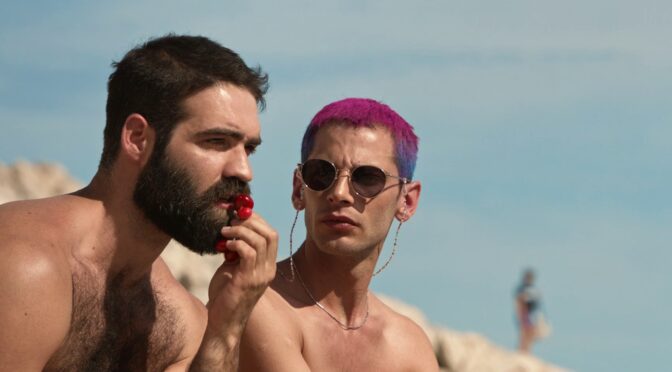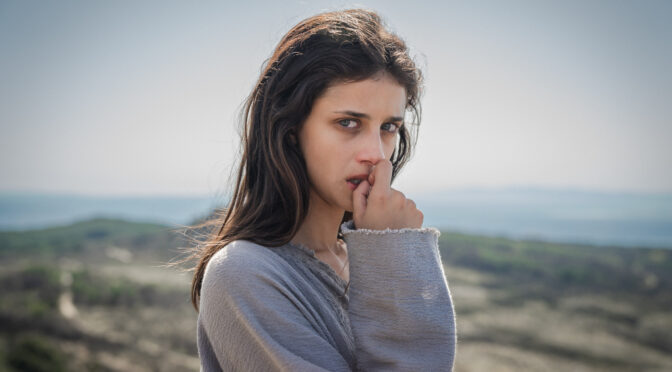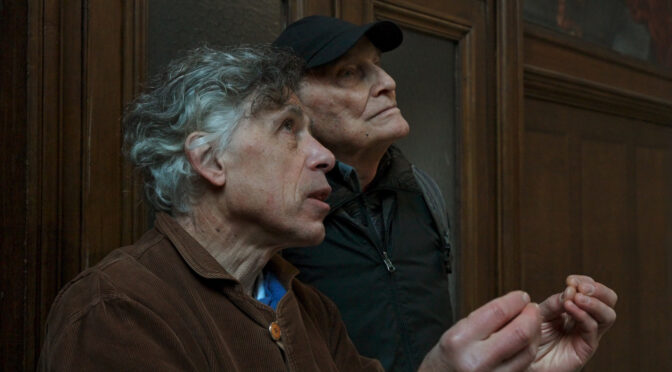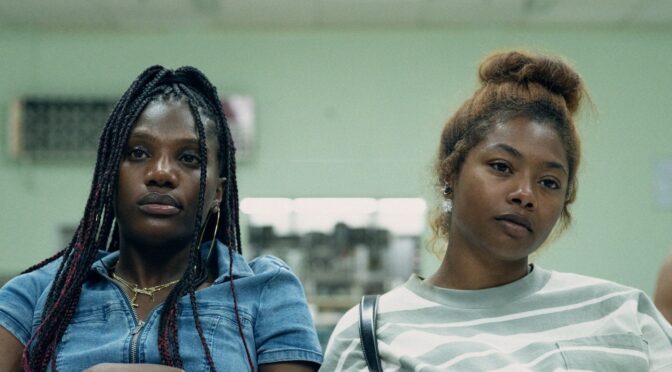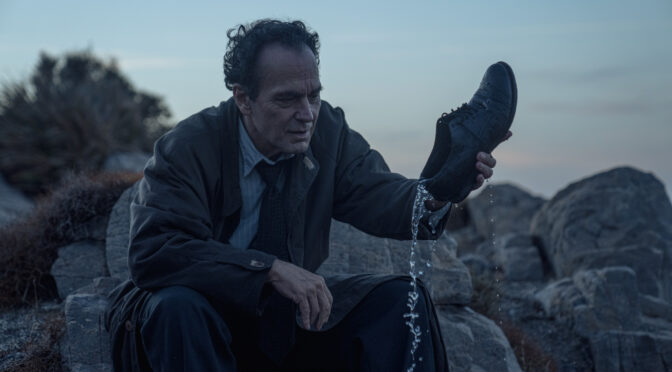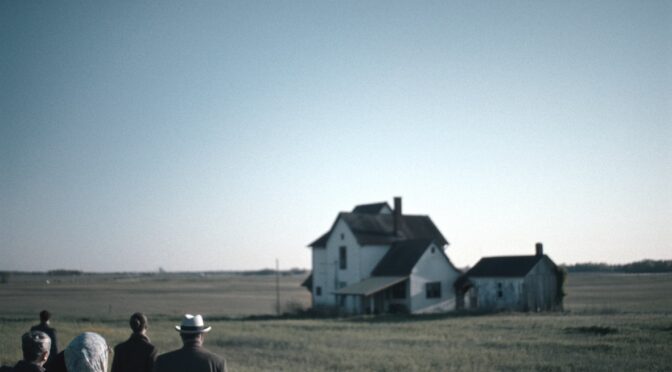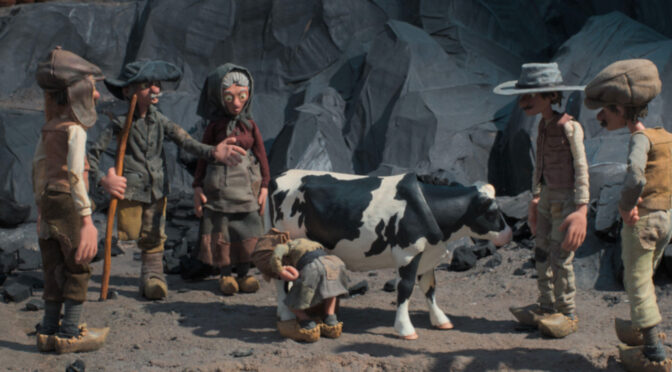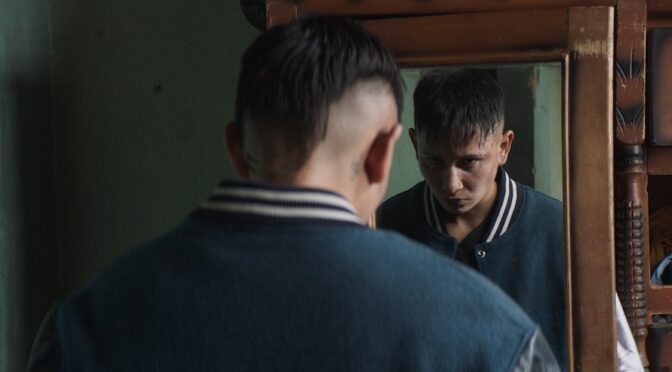Su una scogliera soleggiata a sud di Atene, due ragazzi – l’“eroe” della storia Demostene (Yorgos Tsiantoulas) e l’amico aspirante regista Nikita (Andreas Lampropoulos) – decidono di scrivere la sceneggiatura di un lungometraggio che racconti gli eventi vissuti dal protagonista nell’estate precedente – la rottura con il fidanzato, la successiva adozione del cane (Carmen) dell’ex e la malattia del padre. I ricordi si distendono per tutta la durata del film con la stessa calma dei personaggi al sole e sono inframmezzati dalla leggera e delicata ironia della cornice narrativa. The summer with Carmen di Zacharias Mavroeidis, fuori concorso al 39° Lovers Film Festival, è costruito classicamente come un “racconto nel racconto”, in cui la composizione metadiscorsiva si fa pretesto per interrogare lo spettatore (e i personaggi) sulla velleità delle sovrastrutture narrative che applichiamo alle nostre vite.
Continua la lettura di “THE SUMMER WITH CARMEN” DI ZACHARIAS MAVROEIDISArchivi tag: FUORI CONCORSO
“VANGELO SECONDO MARIA” DI PAOLO ZUCCA
È la storia di una Maria diversa quella raccontata da Paolo Zucca nel suo ultimo film presentato fuori concorso alla 41° edizione del Torino Film Festival, Vangelo secondo Maria, tratto dall’omonimo romanzo di Barbara Alberti.
Continua la lettura di “VANGELO SECONDO MARIA” DI PAOLO ZUCCA“YOU HURT MY FEELINGS” DI NICOLE HOLOFCENER
Fuori concorso, You Hurt My Feelings è l’ultima brillante commedia della regista e sceneggiatrice statunitense Nicole Holofcener che in punta di piedi e con un’ironia calibrata, mette in scena la complessità e la fragilità delle relazioni umane.
Continua la lettura di “YOU HURT MY FEELINGS” DI NICOLE HOLOFCENER“RICARDO ET LA PEINTURE” BY BARBET SCHROEDER
Article by Emidio Sciamanna
Translation by Chiara Rotondo
An elderly painter climbs the steep cliff face of Brittany’s coastline, wearing worn-out clothes and holding his palette, easel and brushes in hand. Upon reaching a secluded grotto, he is free to express his imagination against the stunning coastal backdrop. This is the opening scene of Barbet Schroeder’s latest documentary, Ricardo et la peinture (“Ricardo and painting”), which premiered Out of Competition at the 41st Turin Film Festival.
Continua la lettura di “RICARDO ET LA PEINTURE” BY BARBET SCHROEDER“RICARDO ET LA PEINTURE” DI BARBET SCHROEDER
Abiti consumati, pennelli in mano, tavolozza e cavalletto sulle spalle: nel cuore della Bretagna, sullo sfondo di un suggestivo paesaggio costiero, un anziano pittore si inerpica faticosamente lungo la ripida parete rocciosa di un litorale, fino a raggiungere una piccola grotta nascosta, dove può dare libero sfogo alla sua fantasia. È l’inizio del nuovo documentario di Barbet Schroeder, Ricardo et la peinture, presentato Fuori Concorso alla 41^ edizione del Torino Film Festival.
Continua la lettura di “RICARDO ET LA PEINTURE” DI BARBET SCHROEDER“L’ÎLE” BY DAMIEN MANIVEL
Article by Luca Giardino
Translation by Eleonora Torrisi
Rosa’s (Rosa Berder) last night before leaving for Montréal is an unforgettable party.
The girl must leave all her friends and move to Canada, perhaps to become a great dancer. But goodbyes are never easy and the night offers Rosa a chance to stop time to savor every sip of beer, every drag of a cigarette, and the warmth of the last day of summer. The meeting place is a large boulder in the middle of a beach, affectionately known as “the island”; here her friends set up a sort of farewell ritual, consisting of alcoholic challenges, seaweed battles and bathing in the sea. Rosa lives her last evening as if it were truly the last of her life without ever drowning in memories, but rather trying to recreate new ones that can last forever.
“L’ÎLE” DI DAMIEN MANIVEL
L’ultima sera di Rosa (Rosa Berder) prima di partire per Montréal è una festa indimenticabile. La ragazza deve abbandonare tutti i suoi amici e migrare in Canada, forse per diventare una grande ballerina. Ma gli addii non sono mai facili e la nottata offre a Rosa la possibilità di fermare il tempo per assaporare ogni sorso di birra, ogni tiro di sigaretta e il tepore dell’ultimo giorno d’estate. Il luogo di ritrovo è una grossa roccia in mezzo ad una spiaggia, affettuosamente chiamata “l’isola”; qui i ragazzi allestiscono una sorta di rituale d’addio, fatto di sfide alcoliche, battaglie di alghe e bagni in mare. Rosa vive la sua ultima serata come se fosse veramente l’ultima della sua vita senza mai annegare nei ricordi, ma piuttosto cercando di ricrearne di nuovi che possano vivere in eterno.
Continua la lettura di “L’ÎLE” DI DAMIEN MANIVEL“EARTH MAMA” BY SAVANAH LEAF
Article by Giorgia Andrea Bergamasco
Translation by Eleonora Torrisi
The topic of motherhood has been and still is often addressed in cinema through the most diverse perspectives and sensibilities. Anglo-American filmmaker Savanah Leaf’s approach stands out in the contemporary landscape for its unique freshness and delicacy, making her Earth Mama – based on the short documentary The Heart Still Hums, co-directed with Taylor Russell – an extraordinarily powerful debut feature film.
“EARTH MAMA” DI SAVANAH LEAF
La tematica della maternità è stata e viene tutt’oggi spesso affrontata nel cinema attraverso le più diverse prospettive e sensibilità. L’approccio della regista anglo-americana Savanah Leaf si distingue nel panorama contemporaneo per una freschezza e una delicatezza unica, che rendono il suo Earth Mama – basato sul cortometraggio documentario The Heart Still Hums co-diretto insieme a Taylor Russell – un’opera prima dalla potenza straordinaria.
Continua la lettura di “EARTH MAMA” DI SAVANAH LEAF“LA PRÁCTICA” BY MARTÍN REJTMAN
Article by Enrico Nicolosi
Translation by Alessia Licari
For his 8th feature-length film, La Práctica (“The practice”), Martín Rejtman leaves his beloved Argentina for neighbouring Chile. The main character, Gustavo (Esteban Bigliardi), goes through a journey that is similar to a spiritual retreat trying to reconnect with meditative yoga. Both the director and the main character – who is sort of an alter ego of his creator – will see their innovative dreams clash with reality. As it often happens in the Argentinian director’s films, whatever happens to the helpless characters doesn’t really have a substantial effect in their lives.
Continua la lettura di “LA PRÁCTICA” BY MARTÍN REJTMAN“LA PRÁCTICA” DI MARTÍN REJTMAN
Dopo più di trent’anni di carriera, per il suo ottavo lungometraggio La practica, Martín Rejtman abbandona la sua adorata Argentina per il vicino Cile. Non una rivoluzione, ma una sorta di ritiro spirituale, esattamente come quelli provati dal protagonista Gustavo (Esteban Bigliardi) per ritornare in connessione con la pratica meditativa dello yoga. Sia il regista che il suo personaggio – come non mai alter ego del suo creatore – vedranno i loro sogni di innovazione scontrarsi con la realtà. Infatti, come da prassi nel cinema del maestro argentino, il vortice di vicende che coinvolge gli inermi soggetti non produce alcun effetto sostanziale nelle loro vite, risolvendosi in un grandissimo nulla di fatto.
Continua la lettura di “LA PRÁCTICA” DI MARTÍN REJTMAN“CERRAR LOS OJOS” by Víctor Erice
Article by Fabio Bertolotto
Translation by Camilla Lippi
In Víctor Erice’s movies – four in a career that began fifty years ago – cinema, both as a physical place and as a technical and expressive device, has always played a central role. Her first feature film, The Spirit of the Beehive (El espíritu de la colmena, 1973), told the story of a little girl who was shocked after watching Frankenstein (James Whale, 1931). In El sur (The South) (1983) the protagonist discovered her father’s betrayal in a hall where movies featuring the man’s lover were shown. Cinema as an influential art device, capable of having concrete effects on reality, can also be found in Cerrar los ojos (Close your eyes), the director’s latest work.
Continua la lettura di “CERRAR LOS OJOS” by Víctor Erice“CERRAR LOS OJOS” di Víctor Erice
Nei film di Víctor Erice – quattro in una carriera iniziata ormai cinquant’anni fa – il cinema, sia come luogo fisico che come dispositivo tecnico ed espressivo, ha sempre ricoperto un ruolo centrale. Il primo lungometraggio, Lo spirito dell’alveare (El espíritu de la colmena, 1973), raccontava di una bambina sconvolta dalla visione di Frankenstein (James Whale, 1931). In El sur (1983) la protagonista scopriva il tradimento del padre in una sala dove venivano proiettati i film in cui recitava l’amante dell’uomo. Il cinema come immaginario influente, capace di avere effetti concreti sulla realtà, si ritrova anche in Cerrar los ojos, ultima opera del regista.
Continua la lettura di “CERRAR LOS OJOS” di Víctor Erice“ALL THE COLOURS OF THE WORLD ARE BETWEEN BLACK AND WHITE” DI BABATUNDE APALOWO
If it feels this good, it must be right.
Vincitore del Teddy Award 2023, All the Colours of the World are between Black and White è il primo film a tematica LGBTQ+ ad essere realizzato in Nigeria, paese in cui l’omosessualità può costare fino a 14 anni di carcere. Bambino lavora come rider e, quando non è in sella alla sua moto, si rilassa a casa, tra le attenzioni non corrisposte della bella Ifeyinwa e le litigate dei vicini in piena crisi matrimoniale. Sarà Bawa, proprietario di un negozio di scommesse con la passione per la fotografia, a rompere gli schemi della sua vita così tranquilla.
Continua la lettura di “ALL THE COLOURS OF THE WORLD ARE BETWEEN BLACK AND WHITE” DI BABATUNDE APALOWO“RUNNER” DI MARIAN MATHIAS
Campi sterminati, cieli lividi, vento che soffia impietoso: questo il paesaggio di Runner di Marian Mathias, crudo dramma sociale che racconta la scoperta dell’amore nell’immutabilità del Midwest americano. La storia di Haas, una sorta di Dorothy contemporanea che, come la protagonista de Il mago di Oz, viene colpita da un “ciclone” che la mette in viaggio: la scomparsa del padre e il pignoramento della casa. Partita alla volta dell’Illinois per soddisfare le ultime volontà del defunto, torna con la consapevolezza di poter scegliere del proprio destino.
Continua la lettura di “RUNNER” DI MARIAN MATHIAS“MANODOPERA – INTERDIT AUX CHIENS ET AUX ITALIENS” BY ALAIN UGHETTO
Article by: Emidio Sciamanna
Translated by: Maria Bellantoni
Memories of a distant past that gradually fades in time often remain linked to an ideal world reworked by our minds to preserve emotions, sensations, fleeting instants of our existence in which we have, even for an instant, savoured flashes of true happiness. Manodopera recounts the world evoked by the sweet and nostalgic words of a grandmother, restoring the memory of a bygone era, made up of sacrifices and carefreeness, suffering and love.
The location, recreated in stop-motion, is a small mountain village at the foot of Monviso. It is called Borgata Ughettera and recalls the director Alain Ughetto’s Piedmontese origins. The film comes to life through the words of Cesira, his grandmother, who thinks back to her youth towards the end of the 19th century. Starting from some fundamental events, she thus gives rise to a reality suspended in time that is emphasised by the fragile malleability of the plasticine with which the characters are made of.
Between cardboard houses and bizarre broccoli trees, the objects somehow represent an indispensable aspect of the story; tangible elements whose purpose is to bring the sweetness of a memory closer to the purity of nature. The simplicity of the poor peasant world, the meeting with her future husband Luigi, the difficult periods of war and the need to emigrate to France in order to work and survive: these are the episodes that characterise Cesira’s past and that she describes to her nephew, in a surreal and poetic exchange between the animated universe and the real presence of the director on stage.
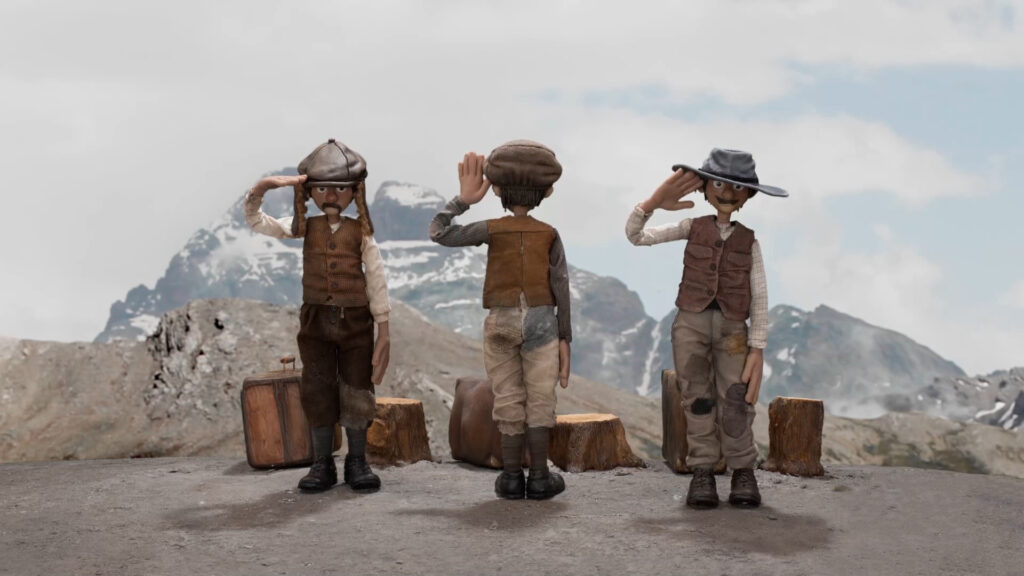
What Ughetto wanted to tell is not only the story of his origins, but also the story of all immigrants, wherever they come from in the world. A story of hard work, of adaptation, of gazes that lacerate the soul and leave irremediable wounds. This is why certain stereotypes in the film take on a different meaning, as if they were the images perceived by those who feel invaded and – not knowing other cultures and not understanding the languages spoken by migrants – judge those from other countries as inferior. As the original title makes clear: “forbidden to dogs and Italians”, a dramatic situation that our families have had to live with in the past and that is being played out again today, this time through the eyes of the viewer.
“MANODOPERA – INTERDIT AUX CHIENS ET AUX ITALIENS” DI ALAIN UGHETTO
I ricordi di un passato lontano che progressivamente svanisce nel tempo rimangono spesso legati a un mondo ideale rielaborato dalla nostra mente per preservare emozioni, sensazioni, fugaci istanti della nostra esistenza in cui abbiamo, anche solo per un istante, assaporato sprazzi di vera felicità. Manodopera racconta il mondo rievocato dalle dolci e nostalgiche parole di una nonna, restituendo la memoria di un’epoca passata, costituita tra sacrifici e spensieratezza, sofferenza e amore.
Il luogo, ricreato in stop motion, è un piccolo paesino di montagna situato ai piedi del Monviso che prende il nome di Borgata Ughettera e richiama le origini piemontesi del regista Alain Ughetto. Il film prende vita attraverso le parole di Cesira, sua nonna, che ripensa alla sua gioventù verso la fine del diciannovesimo secolo. Partendo da alcuni fondamentali avvenimenti, dà così origine a una realtà sospesa nel tempo che la fragile malleabilità della plastilina con la quale sono realizzati i personaggi enfatizza.
Tra case di cartone e bizzarri alberi di broccoli, gli oggetti utilizzati rappresentano in qualche modo un aspetto indispensabile per la storia; elementi tangibili, il cui scopo è quello di avvicinare la dolcezza di un ricordo alla purezza della natura. La semplicità del povero mondo contadino, l’incontro con il futuro marito Luigi, i difficili periodi di guerra e la necessità di emigrare in Francia per poter lavorare e sopravvivere: sono gli episodi che caratterizzano il passato di Cesira e che lei stessa descrive al nipote, in un surreale e poetico scambio tra l’universo animato e la presenza reale del regista sulla scena.

Ciò che Ughetto voleva raccontare non è soltanto la storia delle sue origini, ma anche quella di tutti gli immigrati, da qualsiasi parte del mondo essi provengano. Una storia fatta di fatica, di adattamento, di sguardi che lacerano l’anima e lasciano ferite insanabili. Per questo, alcuni stereotipi presenti nel film assumono un significato diverso, come se fossero le immagini percepite da chi si sente invaso e – non conoscendo le altre culture e non capendo le lingue parlate dai migranti – giudica inferiore chi viene da altri paesi. Come il titolo originale ben evidenzia: “vietato ai cani e agli italiani”, una situazione drammatica in cui in passato le nostre famiglie hanno dovuto convivere e che oggigiorno si ripropone nuovamente, rendendoci stavolta partecipi attraverso gli occhi di chi osserva.
Emidio Sciamanna
“UN VARÓN” BY FABIAN HERNÁNDEZ
Article by: Alice Ferro
Translated by: Cora Bruno
Carlos hangs up the phone and leans against the wall. His eyes are glazed over and he would like to vent but he doesn’t because, as he says, “men don’t cry.” This is the conflict that Un Varón, Fabian Hernández’s new film, sets out to investigate: that of a young man who tries to conform to the ideal of masculinity that prevails on the streets of Bogotá while in private he just wants to be himself. Christmas is approaching and his only wish is to spend it with his increasingly elusive sister and his mother, who is in jail. Leaving the youth center that took him in, he finds himself coming to terms with street life and the law of the alpha male.
read all“ORLANDO” BY DANIELE VICARI
Translated by: Bendetta Francesca De Rossi
Article by: Francesco Ghio
Having a proper compass on which one can rely can often prove to be a necessity in order not to lose one’s way too much; especially in a society which changes its skin year after year. Sometimes the right compass can be found close by, in one’s own backyard, in the apparent simplicity of a sentence spent by a person close to one’s heart; at other times, it is necessary to move away, especially if one’s loved ones, or at least those who once were, have emigrated, crossing borders, hoping for a better future. Daniele Vicari’s Compass for over ten years was Ettore Scola and Orlando, presented out of competition at the 40th Turin Film Festival, is dedicated to him.
READ MORE“ORLANDO” DI DANIELE VICARI
Avere una bussola adeguata sulla quale si possa fare affidamento, spesso, può rivelarsi una necessità per non perdere troppo la strada; soprattutto in una società che muta la propria pelle di anno in anno. A volte la giusta bussola la si può trovare accanto a sé, nel proprio giardino di casa, nell’apparente semplicità di una frase spesa da una persona vicina; altre volte occorre invece allontanarsi, soprattutto se i propri cari, o almeno quelli che un tempo lo sono stati, sono emigrati, superando i confini, sperando in un futuro migliore. La bussola di Daniele Vicari per oltre dieci anni è stato Ettore Scola e Orlando, presentato fuori concorso alla quarantesima edizione del Torino Film Festival, è dedicato a lui.
Continua la lettura di “ORLANDO” DI DANIELE VICARI
